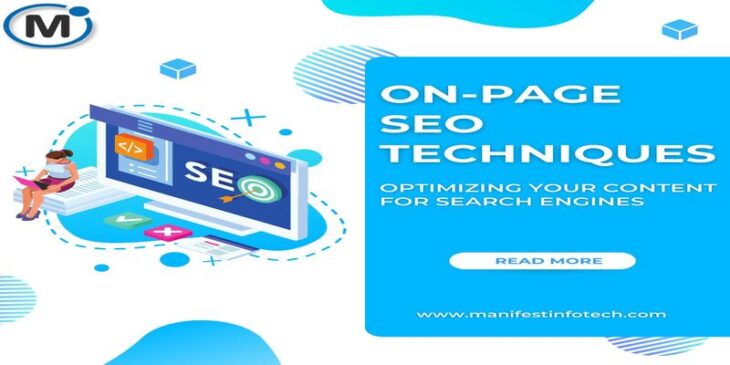
Here are some key on-page SEO techniques to consider:
𝟏. 𝐊𝐞𝐲𝐰𝐨𝐫𝐝 𝐫𝐞𝐬𝐞𝐚𝐫𝐜𝐡: Identify relevant keywords and phrases that your target audience is likely to search for. Use tools like Google Keyword Planner or SEMrush to discover high-volume and low-competition keywords.
𝟐. 𝐓𝐢𝐭𝐥𝐞 𝐭𝐚𝐠𝐬: Craft unique and compelling title tags for each page, incorporating relevant keywords. Keep the title tag under 60 characters to ensure it is fully displayed on the SERPs.
𝟑. 𝐌𝐞𝐭𝐚 𝐝𝐞𝐬𝐜𝐫𝐢𝐩𝐭𝐢𝐨𝐧: Write concise meta descriptions (under 160 characters) that accurately describe your page’s content and entice users to click. Include keywords naturally to increase relevancy.
𝟒. 𝐔𝐑𝐋 𝐬𝐭𝐫𝐮𝐜𝐭𝐮𝐫𝐞: Create search engine-friendly URLs that include relevant keywords and are easy to read. Use hyphens to separate words and keep the URLs concise.
𝟓. 𝐇𝐞𝐚𝐝𝐢𝐧𝐠 𝐭𝐚𝐠𝐬: Use H1 tags for the main title of your page and utilize H2, H3, and so on for subheadings. Incorporate relevant keywords within the headings to improve search engine visibility.
𝟔. 𝐂𝐨𝐧𝐭𝐞𝐧𝐭 𝐨𝐩𝐭𝐢𝐦𝐢𝐳𝐚𝐭𝐢𝐨𝐧: Develop high-quality, unique, and informative content that caters to the needs of your target audience. Use keywords naturally throughout the content but avoid overstuffing.
𝟕. 𝐊𝐞𝐲𝐰𝐨𝐫𝐝 𝐩𝐥𝐚𝐜𝐞𝐦𝐞𝐧𝐭: Include your target keywords in strategic positions such as the page’s title, headings, subheadings, introductory paragraph, and within the body text.
𝟖. 𝐈𝐦𝐚𝐠𝐞 𝐨𝐩𝐭𝐢𝐦𝐢𝐳𝐚𝐭𝐢𝐨𝐧: Optimize image files by using descriptive filenames and alt tags that include relevant keywords. Compress the images to improve page load speed without compromising quality.
𝟗. 𝐈𝐧𝐭𝐞𝐫𝐧𝐚𝐥 𝐥𝐢𝐧𝐤𝐢𝐧𝐠: Link relevant pages within your website to improve navigation and user experience. Anchor text for internal links should be descriptive and include keywords when appropriate.
𝟏𝟎. 𝐔𝐬𝐞𝐫-𝐟𝐫𝐢𝐞𝐧𝐝𝐥𝐲 𝐟𝐨𝐫𝐦𝐚𝐭𝐭𝐢𝐧𝐠: Utilize bullet points, numbered lists, and subheadings to make your content scannable and easy to read. Proper formatting enhances user experience and encourages longer page visits.
𝟏𝟏. 𝐌𝐨𝐛𝐢𝐥𝐞 𝐨𝐩𝐭𝐢𝐦𝐢𝐳𝐚𝐭𝐢𝐨𝐧: Ensure your website is mobile-friendly and responsive, as more users access the internet through mobile devices. Optimize for mobile load times and usability.
𝟏𝟐. 𝐏𝐚𝐠𝐞 𝐥𝐨𝐚𝐝 𝐬𝐩𝐞𝐞𝐝: Improve your website’s load speed by compressing images, minifying CSS and JavaScript files, utilizing browser caching, and choosing a reliable hosting provider.
𝟏𝟑. 𝐒𝐜𝐡𝐞𝐦𝐚 𝐦𝐚𝐫𝐤𝐮𝐩: Implement structured data markup (Schema.org) to provide search engines with additional information about your content.
𝟏𝟒. 𝐒𝐨𝐜𝐢𝐚𝐥 𝐬𝐡𝐚𝐫𝐢𝐧𝐠 𝐛𝐮𝐭𝐭𝐨𝐧𝐬: Incorporate social sharing buttons on your content to encourage readers to share it on social media platforms.
𝟏𝟓. 𝐑𝐞𝐚𝐝𝐚𝐛𝐢𝐥𝐢𝐭𝐲 𝐚𝐧𝐝 𝐮𝐬𝐞𝐫 𝐞𝐱𝐩𝐞𝐫𝐢𝐞𝐧𝐜𝐞: Create content that is easy to read, engaging, and offers a positive user experience. Pay attention to font size, line spacing, paragraph length, and overall design.
If you are looking for any services related to Website Development, App Development, Digital Marketing and SEO, just email us at nchouksey@manifestinfotech.com or Skype id: live:76bad32bff24d30d
𝐅𝐨𝐥𝐥𝐨𝐰 𝐔𝐬:
𝐋𝐢𝐧𝐤𝐞𝐝𝐢𝐧: linkedin.com/company/manifestinfotech
𝐅𝐚𝐜𝐞𝐛𝐨𝐨𝐤: facebook.com/manifestinfotech/
𝐈𝐧𝐬𝐭𝐚𝐠𝐫𝐚𝐦: instagram.com/manifestinfotech/
𝐓𝐰𝐢𝐭𝐭𝐞𝐫: twitter.com/Manifest_info
#OnPageSEO #SEOtechniques #KeywordOptimization #MetaTags #TitleTags #HeaderTags #URLStructure #InternalLinking #ContentOptimization #ImageOptimization #PageSpeed #MobileOptimization #SchemaMarkup #CanonicalTags #KeywordDensity #SEOauditing #HTMLoptimization #UserExperience #StructuredData #SearchEngineOptimization